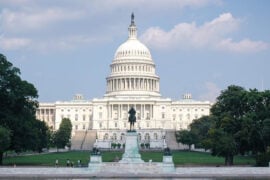In brief
In the waning months of the Trump administration, the then-president signed a raft of executive orders and new legislation that potentially limit access by Chinese companies to US capital markets. Chief among these actions, the Holding Foreign Companies Accountable Act (“Act“) (signed into law on 18 December 2020) bans public trading in the United States in “covered issuers” audited by firms with offices in non-US jurisdictions where the Public Company Accounting Oversight Board (PCAOB) is unable to inspect. The Act stems from a longstanding issue relating to the ability of the PCAOB to conduct inspections of audit firms in certain countries.
- The brevity of the Act belies the complexities that underlie its implementation.
- The SEC, PCAOB and the exchanges face significant challenges in developing rules that both comply with the Act and protect investors and market stability.
- In the meantime, issuers relying on audit reports issued by firms with offices in China should start developing strategies to address the consequences of delisting while still subject to Exchange Act reporting requirements.
In depth
In the waning months of the Trump Administration, the then-President signed a raft of Executive Orders and new legislation that potentially limits access by Chinese companies to U.S. capital markets. Chief among these actions, the Holding Foreign Companies Accountable Act (the “Act“) (signed into law on December 18, 2020) bans public trading in the United States in “covered issuers” audited by firms with offices in non-U.S. jurisdictions where the Public Company Accounting Oversight Board (PCAOB) is unable to inspect. The Act stems from a long-standing issue relating to the ability of the PCAOB to conduct inspections of audit firms in certain countries.
While the Act is not exclusively directed at China, the most consequential aspects of the Act will, absent a change in PRC law, impact Chinese issuers with securities listed and traded in the United States. This paper will provide an overview of the background of the Act, summarize its provisions and discuss the crucial aspects of the Act that must still be addressed by the SEC in its implementing regulations. We will also address steps issuers may wish to take to mitigate the risk of a delisting and prohibition on trading in the United States and the potential consequences for both institutional and retail investors in covered issuers.
Background of the Act
Congress first created the PCAOB to oversee accounting firms with the adoption of the Sarbanes-Oxley Act of 2002 (SOX). With that mandate, the PCAOB adopted auditing standards governing all firms auditing companies subject to the periodic reporting requirements of the Securities Exchange Act of 1934, as amended (the “Exchange Act”). Moreover, SOX required that foreign accounting firms produce audit work papers upon SEC or PCAOB request if such firms issue audit reports, perform audit work or conduct interim reviews, regardless of their materiality or whether a US accounting firm relies on such services. Commencing in 2007, Chinese- and Hong Kong-based audit firms (including affiliates of the Big 4 accounting firms) began to resist PCAOB inspection requests, citing Chinese legal restrictions. While the SEC and PCAOB attempted to negotiate cooperative agreements with China, as had been done with other jurisdictions, Chinese authorities maintained that Chinese laws relating to state secrets and national security prohibited access to audit work papers without prior government approval, effectively prohibiting U.S. access to work papers relating to certain large, multinational state owned enterprises listed on U.S. exchanges. This position was codified into law in March 2020; under Article 177 of the PRC Securities Law, and audit firms operating in China and Hong Kong are forbidden from releasing documentation of Chinese issuers that the authorities deem sensitive without prior government approval.
U.S. legislative and regulatory sentiment towards China has evolved over the last decade following the large influx of Chinese companies listed on U.S. exchanges, recent trade tensions and an accounting fraud relating to a U.S.-listed China-based issuer. The changing sentiment has been reflected in a variety of ways. For instance, on the legislative front the U.S. Congress has considered legislation to require companies to disclose activities relating the Chinese government treatment of Uyghurs. During the Trump administration, the President’s Working Group on Financial Markets proposed measures to alert investors to the risks associated with U.S.-listed Chinese companies and the SEC commenced a rule making process to address those recommendations. These developments occurred in the context of heated public discourse regarding tariffs on Chinese goods, the adoption of new review procedures by CFIUS relating to inbound investment into critical U.S. industries and a prohibition on purchasing the securities of certain companies associated with the Chinese military. Against this backdrop, Congress adopted the Act with large majorities in both the House and Senate and President Trump moved quickly to sign the bill during the last month of 2020 into law.
The Act
The Act imposes disclosure obligations and a potential ban on U.S. trading for certain “covered issuers” (i.e., issuers required to file periodic reports under the Exchange Act). Under the Act, the SEC must identify which covered issuers make Exchange Act annual filings that include audit reports from accounting firms that the PCAOB is unable to inspect “completely” because of the actions taken by non-U.S. regulatory authorities (each such year a “Non-Inspection Year”). The PCAOB must simultaneously designate jurisdictions in which the PCAOB is “unable to inspect or investigate completely” the audit firms or branches providing audit services for covered issuers because of the regulatory positions of local authorities.
Covered issuers identified by the SEC under this process will be required to submit to the SEC documentation establishing that the entity is not owned or controlled by a governmental agency in the foreign jurisdiction. In particular, the issuer must disclose what percentage of the issuer’s securities are held by a foreign government and whether foreign governmental entities have a controlling financial interest, the name of each Chinese Communist Party official on the board of the issuer or its “operating entity” and whether the organizational documents of the issuer contain any “charter of the Chinese Communist Party.”
The Act’s trading ban applies to covered issuers that have three consecutive Non-Inspection Years. The Act then mandates that the SEC prohibit both exchange- and over-the-counter trading in securities issued by such covered issuers. The SEC can end the ban if the issuer certifies to the SEC that it has retained an audit firm that has been inspected by the PCAOB. However, if the issuer subsequently relies on an audit report by an uninspected audit firm, it will be subject to a five-year trading ban.
The SEC must implement the Act’s disclosure requirements within 90 days of the date of enactment. Importantly, the SEC is also required to adopt rules relating to the trading prohibition. Because the Act was clear in mandating that the trading prohibition apply to both exchange- and over-the-counter trading, the SEC’s rulemaking will necessarily extend beyond normal delisting procedures; the SEC will likely need to oversee the modification of existing rules relating to both the de-listing process and the de-registration procedures under the Exchange Act.
Implementing Regulations
While the Act is a model of brevity, a great deal is left to the SEC, the PCAOB and the exchanges to implement the policy objectives of Congress.
Prior to adoption of the Act, the President’s Working Group on Financial Capital Markets had recommended that the SEC and the exchanges condition trading on PCAOB access to the audit papers of an issuer’s principal independent accounting firm; the SEC had initiated a rulemaking process to address new listing standards and auditor qualifications among other matters. With the enactment of the statute, the then Chairman of the SEC directed his staff to consolidate those pending rules with the Act’s disclosure mandates. The then Chairman referenced the need to move expeditiously and to address any actual or perceived uncertainty in a manner consistent with congressional intent as well as investor protection and fair and orderly operation of US markets. The references to uncertainty, investor protection and orderly markets underscore the challenges facing the SEC staff to develop regulations that enforce the trading prohibition of the Act while at the same time not impeding the capital formation, orderly trading and investor protection mandates of the SEC.
Under current regulations, an issuer may either voluntarily delist or be forced to delist by the relevant exchange or the SEC. In either case, the delisting is achieved through a notice to the SEC and shareholders, and the filing of a Form 8-K. But a delisting does not, on its own, result in de-registration of the issuer under the Exchange Act. Absent de-registration, an issuer will continue to have ongoing disclosure obligations arising under Sections 12(b), 12(g) or 15(b) of the Act. Presumably, entities forced to discontinue all trading in the US will have little incentive in continuing to comply with Exchange Act reporting obligations. But the regulations and conditions associated with exiting the Exchange Act are complex and drawn-out. The existing regulations were designed for issuers with very little U.S. trading volume and reflect the SEC’s concerns in protecting investors and the stability of trading markets. As a result, the current process imposes timelines and conditions that may not be necessary or appropriate given the three-year window that precedes the mandatory delisting imposed by the Act. Absent changes to the de-registration process, the timelines and conditions for de-registration will present challenges for de-listed entities that seek a timely exit from the Exchange Act’s requirements.
In contrast to a “normal” delisting process that allows continued over-the-counter trading, the Act creates a complete trading ban for any covered issuer that has three consecutive Non-Inspection Years. The SEC’s existing authority permits the agency to suspend trading, including over-the-counter trading, for a period not to exceed ten days. The SEC also has authority to deregister securities for failure to comply with the Exchange Act’s reporting requirements. The de-registration of an issuer by the SEC also precludes any exchange, broker or dealer from effecting transactions in securities which have been so de-registered. The new or modified SEC rules implementing the mandates of the Act will have to include the ability to prohibit trading for an indeterminate period of time following its conclusion that a covered issuer has had three consecutive Non-Inspection Years and the PCAOB has determined that it cannot “completely” audit the audit firm of such issuer. Importantly, the SEC rulemaking will also have to create a mechanism to reinstate trading if the issuer comes into compliance with the Act by retaining a PCAOB-inspected accounting firm.
The PCAOB may also look to adopt rules (subject to approval by the SEC) interpreting the Act’s requirement that foreign audit firms be subject to “complete” inspection. While the Act’s proponents were principally focused on China-based issuers, the scope of the legislation also covers issuers headquartered and managed in another jurisdiction but with substantial operations in China. As a result, large, foreign-based multinationals with substantial manufacturing and sales operations in China could be within the Act’s scope if their Chinese operations are audited and the PCAOB’s access to the relevant audit papers is impeded. Given this, following passage of the Act by the House, two congressmen offered the view that the SEC and PCAOB should view the “completely” requirement as referencing audits in which 30% or more of the audit was conducted in China. It is unclear whether and how this 30% concept would be implemented, but PCAOB and SEC guidance will be necessary to define the Act’s reach.
Likewise, the exchanges may adopt new rules relating to the de-listing process in concert with the SEC’s expected rulemaking. The exchanges had previously proposed new listing requirements for issuers that principally administer their business from China and may now consider other rules to address any perceived market disruptions accompanying the de-listing mandates, such as an extended de-listing notice period following an SEC determination that a covered issuer has three consecutive Non-Inspection Years.
The Financial Industry Regulatory Authority (“FINRA”), the self-regulatory body responsible for direct oversight of the broker-dealer industry, also has regulatory authority for the over-the-counter market. As the SEC implements its own regulations, it will likely coordinate with FINRA to develop rules applicable to the over-the-counter market to implement the Act’s trading ban.
Recent Developments in Other Markets
The U.S. regulatory and political environment with respect to the Act and Chinese issuers generally has not gone unnoticed by regulators and exchange officials around the world. Regulators and exchanges in China, in particular, have emphasized potential benefits from bringing Chinese issuers back to local exchanges for their primary listing. The Hong Kong Exchange has implemented new listing standards to attract Chinese listings, including allowing weighted voting rights structures often used by technology companies that otherwise might list in the US. The London Exchange has likewise initiated consideration of dual class structures on its exchange and, during 2020, initiated with the Shanghai Exchange the Shanghai-London Stock Connect which facilitates dual listing and trading on the two exchanges.
Implications for Covered Issuers and Investors
The Act has significant implications for covered issuers with substantial operations in China and those funds and individuals that invest in them. As of October 2020, it was estimated that 217 China based public companies with an aggregate market cap of approximately $2.2 trillion were traded on the US markets. The delisting of a meaningful number of these entities would have significant implications for registered investment companies, broker-dealers and the relevant trading markets as well as the issuers. For those entities that are forced into a delisting, trading volumes will potentially spike as investors seek to exit the securities and liquidity will diminish as institutional investors reduce their exposure and substantial sell-side pressure is met with declining interest from buy-side investors. Index funds will likewise seek to liquidate their positions as the issuers are eliminated from the relevant indices. As the SEC and FINRA adopt implementing rules, broker dealers will have to halt trading activity in the securities of the delisted entities and those with foreign affiliates, may need to consider changes to internal compliance procedures with respect to offshore trading in the relevant securities. Likewise, broker-dealers involved in private placements and 144A placements may consider limiting their engagement with issuers based in China either in response to regulatory mandates or market conditions.
We expect that some Chinese issuers will consider secondary listings in other markets as a means of ensuring continued liquidity in the event of a US delisting and, potentially, positioning the issuer for de-registration under the Exchange Act. As noted above, the London Exchange has implemented a number of listing changes that may facilitate a secondary listing for those issuers impacted by a US de-listing, but it may take time for larger issuers to create a sufficiently deep trading market in a secondary market to offset the liquidity afforded by the U.S. market. Accordingly, Chinese issuers may need to commence planning and consideration of various markets as an alternative to the United States. Smaller issuers may have less ability to attract trading activity in secondary markets and may be forced to consider a merger or going private transaction to exit the U.S. market at a time and on terms that they can control rather than being subject to a de-listing process driven by regulatory requirements. Foreign issuers also will need to consider alternative means of reducing U.S. trading volumes, perhaps by voluntarily delisting and trading purely over-the-counter well in advance of any decision by the SEC. If U.S. trading volume and ownership numbers for such issuers drop sufficiently, the issuer may comply with the existing requirements for Exchange Act de-registration. Another alternative would be to initiate a stock repurchase program or issuer tender offer in the United States to U.S. share owners; however, such transactions potentially trigger other regulatory hurdles associated with going-private transactions.
The brevity of the Act belies the complexities that underlie its implementation. The SEC, PCAOB and the exchanges face significant challenges in developing rules that both comply with the Act and protect investors and market stability. In the meantime, issuers relying on audit reports issued by firms with offices in China should start developing strategies to address the consequences of delisting while still subject to Exchange Act reporting requirements.




